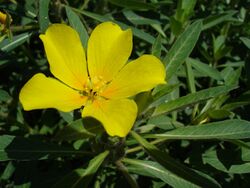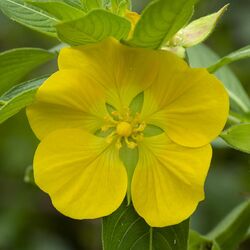Biology:Ludwigia grandiflora
| Ludwigia grandiflora | |
|---|---|

| |
| Scientific classification | |
| Kingdom: | Plantae |
| Clade: | Tracheophytes |
| Clade: | Angiosperms |
| Clade: | Eudicots |
| Clade: | Rosids |
| Order: | Myrtales |
| Family: | Onagraceae |
| Genus: | Ludwigia |
| Species: | L. grandiflora
|
| Binomial name | |
| Ludwigia grandiflora (Michx.) Greuter & Burdet
| |
| Synonyms[1] | |
|
List
| |
Ludwigia grandiflora, the water primrose, is an aquatic plant of the order Myrtales.[2]
It is closely related and easily confused with Ludwigia hexapetala.[3] The two species can be distinguished at a chromosomal level, because L. grandiflora is hexaploid and L. hexapetala is decaploid.[4] However, they can be distinguished morphologically. L. grandiflora has villous hairs, smaller flowers and smaller pollen grains.[4] Some authorities consider that these differences are too slight to consider these different species and so separate these taxa as two varieties or two subspecies.[5][6]
Invasive species
Ludwigia grandiflora has been listed on the List of Invasive Alien Species of Union concern since 2016[7] and in the United States it is on the South Carolina State-listed Noxious Weed list.[8] It out-competes other plants by forming dense mats at the margins and in ponds.[9] It is introduced to warm temperate areas of North America, Japan and Europe and has formed large stable populations, particularly in France.[10]
Life history
Ludwigia grandiflora can, and does, produce viable seed, but it is also highly effective at vegetative reproduction and apparently recruitment of new plants from seed is low.[11] The large showy flowers attract a wide variety of insects. A study in Belgium, where L. grandiflora is introduced, showed that the flowers are visited by a wide variety of insects including bees, Lepidoptera, beetles and hoverflies.[12]
References
- ↑ "Ludwigia grandiflora (Michx.) Greuter & Burdet" (in en). Royal Botanic Gardens, Kew. http://www.plantsoftheworldonline.org/taxon/943788-1.
- ↑ "The Plant List: A Working List of All Plant Species". The Plant List. http://www.theplantlist.org/tpl1.1/record/tro-23201747.
- ↑ Jacono, Colette. "Identification of common aquatic water-primrose species, Ludwigia, in Florida". https://plants.ifas.ufl.edu/wp-content/uploads/files/caip/pdfs/LudwigiaIDGuide.pdf.
- ↑ 4.0 4.1 Zardini, Elsa M.; Gu, Hongya; Raven, Peter H. (1991). "On the separation of two species within the Ludwigia uruguayensis complex (Onagraceae)". Systematic Botany 16 (2): 242. doi:10.2307/2419276.
- ↑ Ward, Daniel Bertram (2012). "New combinations in the Florida Flora III". Phytologia 94 (3): 459–485. https://biodiversitylibrary.org/page/47218840. Retrieved 2020-01-28.
- ↑ Nesom, Guy; Kartesz, John (2000). "Observations on the Ludwigia uruguayensis complex (Onagraceae) in the United States". Castanea 65 (2): 123–125.
- ↑ "List of Invasive Alien Species of Union concern - Environment - European Commission". https://ec.europa.eu/environment/nature/invasivealien/list/index_en.htm.
- ↑ "South Carolina State Noxious Weeds List | USDA PLANTS". https://plants.usda.gov/java/noxious?rptType=State&statefips=45.
- ↑ "Ludwigia grandiflora - Bugwoodwiki". https://wiki.bugwood.org/Ludwigia_grandiflora.
- ↑ Dandelot, Sophie; Verlaque, Régine; Dutartre, Alain; Cazaubon, Arlette (2005). "Ecological, dynamic and taxonomic problems due to Ludwigia (Onagraceae) in France". Hydrobiologia 551 (1): 131–136. doi:10.1007/s10750-005-4455-0.
- ↑ Okada, Miki; Grewell, Brenda J.; Jasieniuk, Marie (2009-10-01). "Clonal spread of invasive Ludwigia hexapetala and L. grandiflora in freshwater wetlands of California" (in en). Aquatic Botany 91 (3): 123–129. doi:10.1016/j.aquabot.2009.03.006.
- ↑ Stiers, Iris; Triest, Ludwig (2017-10-01). "Low interspecific pollen transfer between invasive aquatic Ludwigia grandiflora and native co-flowering plants" (in en). Biological Invasions 19 (10): 2913–2925. doi:10.1007/s10530-017-1494-1. https://www.semanticscholar.org/paper/60d358006d338474554a9c1abd287151f58950ce. Retrieved 2020-02-03.
Wikidata ☰ Q3266274 entry
 |


